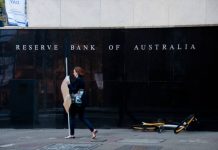ECB’s Rehn sends the euro down, Jackson Hole in focus
After a rough week for equity investors and despite the fact that the level of fear remain elevated, some stability has return to financial markets. Equity futures are inching their way in positive territory as implied volatility measures slowly decrease. The German DAX is up 0.75%, the EuroSTOXX 50 0.85% and the FTSE hasn’t opened yet as the LSE took unscheduled holidays (technical issue). Safe haven assets are edging lower with the yellow metal sliding towards the $1,500 level. In the FX market, the Swiss franc and the Japanese yen are down 0.23% and 0.05% against the greenback to 0.9788 and 106.15, respectively. Finally, Bitcoin is currently fighting to maintain itself above the rising trend line that supported the rally initiated in May this year and currently trades around $9,890.
The single currency continued to move lower following ECB’s Rehn comments to the Wall Street Journal where he declared that the ECB is preparing “a very strong package” that should include both additional bond purchase and a cut in interest rates. He added that “When you’re working with financial markets, it’s often better to overshoot than undershoot, and better to have a very strong package of policy measures than to tinker,” You’ll be warned, the ECB is in for the kill and bond yields will have no chance. For now, investors are expecting a cut of 0.1%, currently at -0.5%, and the restart of the quantitative program with €50bn per month of bond purchase. However, that was before Mr. Rehn comments. Now, the market is pricing a 60% chance of a 20bps cut and 40% of a 10bps cut. In addition, it wouldn’t be surprising if the ECB extend the scope of its QE by buying different assets such as… stocks. However, it is more likely that the ECB would end up extending the limit of 33% of issued amount outstanding per country.
Across the Atlantic, investors already started to look towards Jackson Hole, where the Fed’s annual symposium will be held between 22 and 24 August. Market participants will be keen to get fresh hints from Jerome Powell regarding the FOMC thinking ahead of the mid-September meeting. We believe that the Fed Chair wouldn’t miss the occasion to take a dovish stance, just like all the other central banks across the globe. Is QE4 on its way?
Oil optimism likely to ease as growth outlook worries
Oil prices are surprisingly robust considering the latest headlines that emerged in August. Between trade spat titles, recession fears and weak economic data releases confirming a drop in China’s industrial production and a decline in Germany’s exports, confirmed by slowing 2Q GDP data, all elements were united to pressure oil back towards early August levels. Yet, oil traders appear rather optimistic that a quick fix between the world’s two largest economies would occur in the near future as US President Donald Trump is expected to plan a call and a potential face-to-face meeting with his counterpart Xi Jinping that would include both Hong Kong protests and trade matters, “soon”. Under current circumstances and despite the OPEC+ attempt to curb production, the prospect of oil prices along October 2018 high is still far from achievable.
Indeed, despite a potential short-term rebound in oil prices due to positive headlines on topics such as the US-China trade war or the release of an Iranian oil tanker in the Gulf of Gibraltar, it seems that the longer-term outlook is not boding well when looking at global demand. Negative output gap across economies and slowing inflation, as is the case of Mexico, whose central bank, Banxico, finally cut rate by 0.25% percentage points to 8% for the first time in 5 years, following the Fed’s footsteps in a similar fashion as New Zealand, Thailand or Philippines, should not turn in favor of oil. Therefore, the OPEC’s largest producer Saudi Arabia, willingness to reduce production further if necessary has probably become a minimum measure to stabilize prices at current levels. On a side note, WTI – Brent crude spreads are now lowest since 20 July 2018, reflecting continued congestion of crude oil pipeline transportation from Permian basin to refineries and plans to build up crude export terminals in the Gulf of Mexico in order to increase shipments to foreign markets. The latter would imply that WTI should become much more sensitive to global demand developments, although projects are not expected to start before 2020.
WTI is currently trading at 55.61, approaching 56 short-term and set for a weekly gain following two weeks in negative territory












